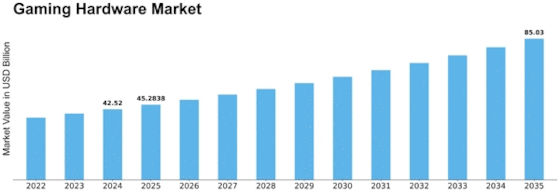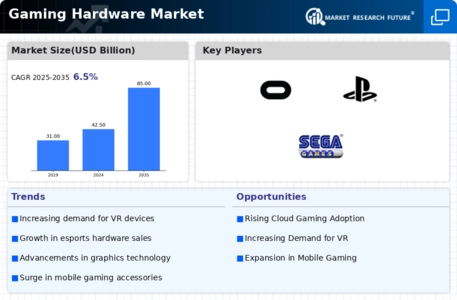Gaming Hardware Size
Gaming Hardware Market Growth Projections and Opportunities
The gaming hardware market is a dynamic and rapidly evolving industry, influenced by a multitude of market factors that shape its growth and trends. One of the key drivers of this market is the continuous advancement in technology. As gaming enthusiasts demand more realistic and immersive gaming experiences, manufacturers are compelled to innovate and introduce cutting-edge hardware. Graphics processing units (GPUs), central processing units (CPUs), and other essential components are constantly upgraded to meet the increasing demands of modern games, driving the overall growth of the gaming hardware market.
Consumer preferences and gaming trends also play a significant role in shaping the gaming hardware market. The rise of esports and the increasing popularity of multiplayer online games have led to a surge in demand for high-performance gaming peripherals such as gaming mice, keyboards, and headsets. As gamers seek a competitive edge, manufacturers respond by developing specialized hardware tailored to the specific needs of the gaming community. Additionally, the growing interest in virtual reality (VR) and augmented reality (AR) gaming experiences has further expanded the scope of the gaming hardware market.
Market competition is another crucial factor influencing the gaming hardware industry. Key players in the market, such as NVIDIA, AMD, Intel, and various gaming peripheral manufacturers, engage in intense competition to capture a larger share of the market. This competition drives innovation, encourages price competitiveness, and ultimately benefits consumers by offering a diverse range of products with varying features and price points. Partnerships and collaborations between gaming hardware manufacturers and game developers also contribute to the market's growth, as optimized hardware-software integration enhances the overall gaming experience.
The global economic landscape and disposable income levels impact the gaming hardware market as well. During economic downturns, consumers may prioritize essential purchases over luxury items like high-end gaming hardware. Conversely, during periods of economic prosperity, there is an increased willingness to invest in premium gaming setups. Additionally, the affordability of gaming hardware has a direct impact on market accessibility. Lower-priced entry-level gaming peripherals make gaming more accessible to a broader audience, contributing to market expansion.
Technological convergence and the integration of gaming capabilities into multifunctional devices are shaping the gaming hardware market's future. Smartphones, tablets, and even smart TVs with gaming capabilities are becoming increasingly prevalent. This trend has led to the development of gaming peripherals compatible with a variety of devices, expanding the market beyond traditional gaming PCs and consoles. As gaming becomes more ubiquitous across different platforms, the demand for versatile and cross-compatible gaming hardware continues to rise.
Environmental and sustainability considerations are emerging as influential factors in the gaming hardware market. With a growing awareness of electronic waste and the environmental impact of manufacturing processes, consumers are showing interest in eco-friendly and energy-efficient gaming hardware options. Manufacturers are responding by incorporating sustainable practices into their production processes and designing products with longevity and recyclability in mind.

















Leave a Comment